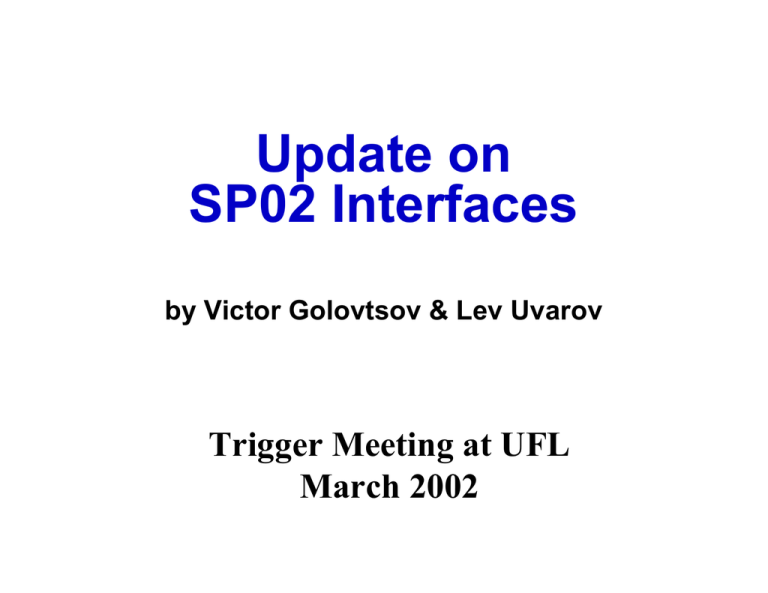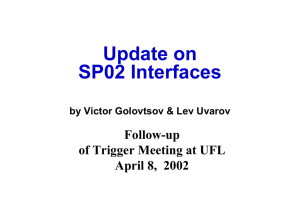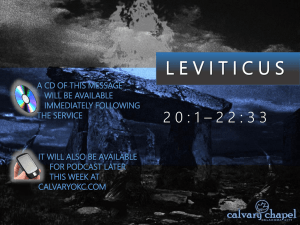Update on SP02 Interfaces Trigger Meeting at UFL March 2002
advertisement

Update on SP02 Interfaces by Victor Golovtsov & Lev Uvarov Trigger Meeting at UFL March 2002 SP02 Interfaces ● ● ● VME Interface CCB Interface MPC Interface ! ● ● DDU Interface FM Interface ! ● ● MPC Data Validation Fast Monitoring Signals MS Interface DT Interface CSC Trigger Meeting at UFL - March 22, 2002. 2 Victor Golovtsov, Lev Uvarov PNPI / University of Florida VME Interface (P1/J1) VME Interface ! A24D16 Slave ! AM = (0x39, 0x3A, ox3B, 0x3D, 0x3E, 0x3F) ! Near 64 Mbytes of addressable space Internal Bus for Write/Read operations: ! D16 Bi-directional Data Lines ! Up to A10 Address Lines ! WR*/RD Control ! 8 x CE* Controls Address space Considerations: ! GA address space [GA4:GA0] = 5 bits => [A23:A19] => Address space is limited to 512 Kbytes ! Address space for each chip is determined by a chip code, 8 bits for 8 chips => [A18:A11] ! Address space for registers inside each chip = 10 bits => [A10:A1] ! Addressing scheme allows board-wide and chip-wide broadcast writes to save time on LUT downloading A23 A22 A21 A20 A19 A18 A17 A16 A15 A14 A13 A12 A11 A10 A9 A8 A7 A6 A5 A4 A3 A2 A1 GA # Chip # CSC Trigger Meeting at UFL - March 22, 2002. Register # 3 Victor Golovtsov, Lev Uvarov PNPI / University of Florida CCB Interface S ig n a l L in e s D ir e c tio n C lo c k B u s T ype L o g ic D u r a tio n C C B _ C LO C K 4 0 2 IN P o in t-to -p o in t LV D S 40M Hz C C B _ C LO C K 4 0 _ E N A B LE 1 IN B u ssed GTLP P u lse, n c o u n ts S u b to ta l 3 F a st C o n tr o l B u s C C B _ C M D [5 ..0 ] 6 IN B u ssed GTLP Lev el CC B_EV CNTRES 1 IN B u ssed GTLP 25ns CC B_BCNTRES 1 IN B u ssed GTLP 25ns C C B _C M D _STR O B E 1 IN B u ssed GTLP 25ns CC B_BC0 1 IN B u ssed GTLP 2 5 n s+ E C L F P C C B _ L1 A C C E P T 1 IN B u ssed GTLP 2 5 n s+ E C L F P C C B _ D A T A [7 ..0 ] 8 IN B u ssed GTLP Lev el C C B _D ATA_STR O B E 1 IN B u ssed GTLP 25ns C C B _ R E S E R V E D [3 ..0 ] 4 IN B u ssed GTLP 1 IN B u ssed GTLP S ta tic lev el CC B_READY S u b to ta l 25 R e lo a d B u s SP_H AR D _R ESET 1 IN B u ssed GTLP 300ns SP_C FG_D O N E 1 OUT P o in t-to -P o in t GTLP Lev el B u ssed GTLP S u b to ta l 2 R e se r v e d L in e s S P _ R E S E R V E D [3 ..0 ] 4 S u b to ta l T o ta l OUT Local T rig g e r 4 34 Provisions to run in Local mode: • If a valid track found, SP generates a 25 ns signal (SP trigger) on the backplane bussed line; • SP Triggers from different cards are wire ORed; • CCB receives an OR of SP Triggers and, considering it as an L1A Local (L1AL), distributes it to other SPs and Peripheral crates. (care should be taken in CCB to protect system from L1AL flood) CSC Trigger Meeting at UFL - March 22, 2002. 4 Victor Golovtsov, Lev Uvarov PNPI / University of Florida MPC Interface Frame 1 2 15 14 13 12 VP Quality CSC ID 11 10 09 08 07 06 05 CLCT Pattern # BC0 BX0 SE L/R 04 03 02 01 Wire Group ID CLCT Pattern ID CLCT Pattern ID For high pT patterns, the 8-bit half-strip ID is between 0 and 159. For low pT patterns, the 8-bit di-strip ID is between 0 and 39. This number corresponds to the position of the pattern selected at the third or “key” layer of the chamber CLCT Pattern # The 4-bit pattern number encodes the number of layers and whether the pattern consists of half-strips or di-strips. Higher pattern numbers are assigned to straighter high-momentum tracks with more layers hit. L/R The Left/Right bend bit indicates whether the track is heading towards lower or higher strip number. Quality Wire Group ID CSC ID 00 The more hits the higher track Quality The 7-bit Wire Group ID indicates the position of the pattern within the chamber and runs from 0 to 111. The 4-bit CSC ID indicates the chamber # and runs from 1 to 9. VP The Valid Pattern flag indicates a valid LCT pattern has been found and information is being sent on the current clock cycle. SE Synchronization Error bit. BC0 The Bunch Crossing Zero flag marks bunch zero data. BX0 The least significant bit of Bunch Crossing Number (BXN ranges from 0 to 3563) CSC Trigger Meeting at UFL - March 22, 2002. 5 Victor Golovtsov, Lev Uvarov PNPI / University of Florida MPC Data Validation • Every turn Front FPGA compares BC0s coming along the data stream and BC0 coming from the CCB against FPGA’s internal counter • If a mismatch is found all subsequent events are marked with SE=1 bit • Every bunch crossing Front FPGA compares BX0 bit against the corresponding bits of its internal counter; • If a mismatch is found, Front FPGA sets SE=1 • Every bunch crossing Front FPGA checks an SE bit • If SE=1 found, then Front FPGA sets VP=0 (if not set already) • A VME control bit enables/disables the above option • Front FPGA feeds Main FPGA with the modified data • For ME1, Front FPGA informs DT about the invalid pattern by setting Q=0 • Front FPGA stores modified data in the pipeline delay for readout upon L1A Front FPGA counts every synch error. The counter content is available over VME Interface CSC Trigger Meeting at UFL - March 22, 2002. 6 Victor Golovtsov, Lev Uvarov PNPI / University of Florida DDU Interface • The DDU Interface mostly retains its status as of the December 2001 Trigger Meeting at UCLA , see http://www.phys.ufl.edu/~uvarov/tf_crate/interfaces.htm • Provisions have been made to follow the 1(control)+15(data) bit convention used in the DMB-DDU interface to minimize DDU adjustments for the SP readout. • DDU Payload at 100 kHz L1A rate is shown below Units Full Event Zero-Suppressed Inputs No Event 2 2 8 8 8 8 8 4 8 4 2 2 (36*2+28*10)/12 =29 2.9*106 5.8*106 35*106 70*106 Header Only Fast Monitoring Only Event Start-of-Frame Header Output Block Input Block 1 Input Block 2 End-of-Frame Total Payload per SP Payload per SP Payload per DDU Payload per DDU Words Words Words Words Words Words Words 2 8 8 40 40 2 100 Words/sec Bytes/sec Words/sec Bytes/sec 10*106 20*106 120*106 240*106 CSC Trigger Meeting at UFL - March 22, 2002. 7 2 8 2 2 12 2 4 1.2*106 2.4*106 14*106 29*106 0.4*106 0.8*106 4.8*106 9.6*106 Victor Golovtsov, Lev Uvarov PNPI / University of Florida FM Interface SP02 uses the latest approach for collecting FM (Fast Monitoring) information: • Number of FM signals is reduce from 5 to 4 (ERR coded by RDY=BSY=1) combination • FM signals are routed to RJ45 front panel jack • Electrical standard – LVDS differential CSC Trigger Meeting at UFL - March 22, 2002. 8 Victor Golovtsov, Lev Uvarov PNPI / University of Florida Fast Monitoring Signals - 1 • RDY • There three cases to consider: 1. Power-on condition 2. Hard Reset condition 3. L1 Reset condition o o o o • All FPGA configuration processes get completed (corresponding FPGA DONE signals became HIGH) (1,2) All FPGA registers (1,2) and LUTs (1) have been loaded with the proper data and a VME-controlled READY trigger has been set to HIGH MPC-SP synchronization procedure has been accomplished (Front FPGA has issued the /Alignment_FIFO_Read signal and data started flowing from the Front FPGAs) (1,2,3) Input data has reached the output of the L1 Pipeline FIFO (may be redundant, since there is a “natural delay” in the RDY-L1A loop that the Data Delay FIFO is intended to compensate anyway) (1,2,3) The SP02 RDY signal is a logical AND of the above conditions CSC Trigger Meeting at UFL - March 22, 2002. 9 Victor Golovtsov, Lev Uvarov PNPI / University of Florida Fast Monitoring Signals - 2 • BSY • SP is BUSY, when it is not READY • WOF • The DDU Interface is responsible for L1A processing; so only it is capable to issue the WOF signal based on knowledge of the number of L1A received and the number of events transmitted to DDU. • ERR • Input link failure – when optical receiver SD (signal detect) has gone • OSY • Each Front FPGA issues an OSY signal if number of input stubs with SE bit set exceeds a preset threshold from a given opto-link. There are several reasons why input stub could be marked as an out of synch stub: • either input stub has been received with the SE bit already set, • or the BX0 bit does not match the expected values and the SE bit has been set by the Front FPGA logic. • The SP02 OSY signal is a logical OR of all Front FPGA and Main FPGA OSY signals. CSC Trigger Meeting at UFL - March 22, 2002. 10 Victor Golovtsov, Lev Uvarov PNPI / University of Florida MS Interface Two 32-bit Frames at 80 MHz each bunch crossing Phi Eta Rank * Valid Charge 5 5 7 1 Bits / 3 µ (1 SP) 15 15 21 3 Halo Muon Charge BX0 BC0 SE Spare Total: 1 1 – – – 20 3 3 1 1 1 1 64 Signal Bits / µ Description Azimuth coordinate Pseudorapidity 5 bits pT + 2 bits quality Charge assignment OK? (8th bit from Rank LUT) Halo muon trigger Muon sign LSB of BXN Bunch Crossing Zero flag Synch Error Need to assign bits to frames, keeping in mind that Rank comes from the PT LUT later than the rest of the bits (up to MM preferences) CSC Trigger Meeting at UFL - March 22, 2002. 11 Victor Golovtsov, Lev Uvarov PNPI / University of Florida DT Interface To be Presented by Darin Acosta CSC Trigger Meeting at UFL - March 22, 2002. 12 Victor Golovtsov, Lev Uvarov PNPI / University of Florida





